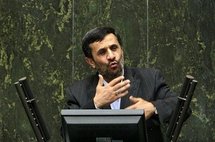
But it was not yet certain whether the text would win the support of the majority of board members in negotiations ahead of the meeting, so the so-called P5+1 may finally decide to issue it merely as a statement rather than put it to the vote, another diplomat said.
Both spoke on condition of anonymity, given the sensitive nature of the matter.
The IAEA has not adopted a resolution on Iran since February 2006. But Iran's shock revelation in September that it has been building a second enrichment plant -- in defiance of UN sanctions to halt uranium enrichment altogether -- has enraged even Russia and China, which have previously been reluctant to join western countries' call for tougher action against Iran.
The P5+1 met in Brussels last week where there was a high level of agreement on the seriousness of the latest revelation, the diplomats said.
Iran revealed to the IAEA in September that it had built a second uranium enrichment plant inside a mountain near Qom, triggering new outrage in the West over the nuclear drive, even though Iran denies it is trying to build a bomb.
Iran has been enriching uranium for several years at a plant in the central city of Natanz, in defiance of three sets of UN sanctions. Uranium is used for fuel for civilian reactors, but in highly enriched form can also make the fissile core of an atomic bomb.
In its first official report since IAEA experts inspected the Qom site last month, the watchdog complained a week ago that Tehran's delay in disclosure "does not contribute to the building of confidence."
Iran said the site was planned as a back-up plant should the Natanz plant be bombed.
During their visit to the Qom site, IAEA inspectors verified that the plant was built to contain around 3,000 uranium-enriching centrifuges, but experts say that would not be sufficient to cover a civilian power programme,
The Natanz plant currently has around 8,000 centrifuges installed.
---------------------------------------------------------------------------------------------------------------------------------
Image: AFP/File/Atta Kenare.
Both spoke on condition of anonymity, given the sensitive nature of the matter.
The IAEA has not adopted a resolution on Iran since February 2006. But Iran's shock revelation in September that it has been building a second enrichment plant -- in defiance of UN sanctions to halt uranium enrichment altogether -- has enraged even Russia and China, which have previously been reluctant to join western countries' call for tougher action against Iran.
The P5+1 met in Brussels last week where there was a high level of agreement on the seriousness of the latest revelation, the diplomats said.
Iran revealed to the IAEA in September that it had built a second uranium enrichment plant inside a mountain near Qom, triggering new outrage in the West over the nuclear drive, even though Iran denies it is trying to build a bomb.
Iran has been enriching uranium for several years at a plant in the central city of Natanz, in defiance of three sets of UN sanctions. Uranium is used for fuel for civilian reactors, but in highly enriched form can also make the fissile core of an atomic bomb.
In its first official report since IAEA experts inspected the Qom site last month, the watchdog complained a week ago that Tehran's delay in disclosure "does not contribute to the building of confidence."
Iran said the site was planned as a back-up plant should the Natanz plant be bombed.
During their visit to the Qom site, IAEA inspectors verified that the plant was built to contain around 3,000 uranium-enriching centrifuges, but experts say that would not be sufficient to cover a civilian power programme,
The Natanz plant currently has around 8,000 centrifuges installed.
---------------------------------------------------------------------------------------------------------------------------------
Image: AFP/File/Atta Kenare.









 Home
Home Politics
Politics









